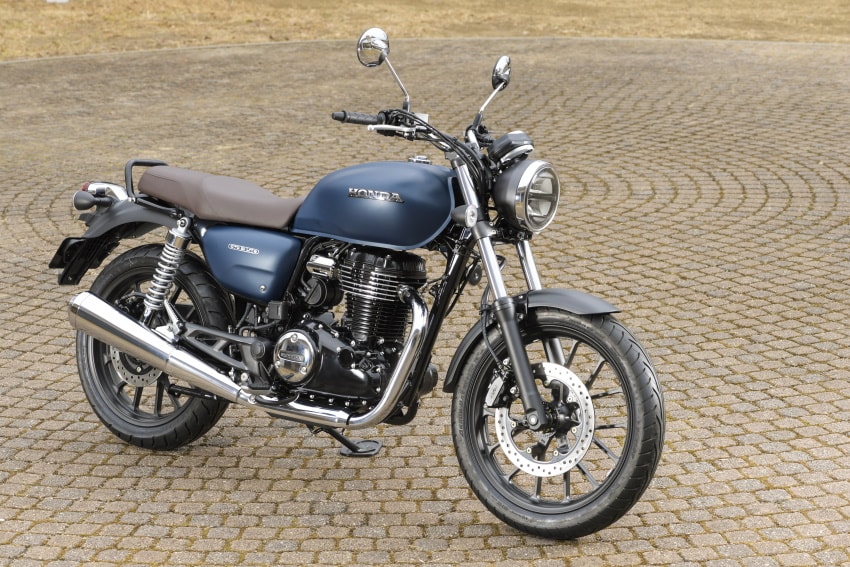The GB350 has been officially announced. To be honest, I was not very interested in this air-cooled SOHC 2-valve single-cylinder motorcycle because I heard that it was based on the Hynes CB350 produced in India for the Indian market.
However, after learning the details, I was extremely impressed. I was convinced that the significance and presence were released in the goodness of a single.
This balancer arrangement is revolutionary!Unique technology built into the basic and simple
The engine is a super long stroke. It's easy to feel the engine's breathing - intake, compression, combustion and exhaust. The maximum output rpm is low at 5500 rpm, so you can enjoy the feeling of a non-continuous throbbing.
The average piston speed is 18.1 m/s when the piston moves back and forth over a 90.5 mm stroke at 6000 rpm. That's a lot of piston action for an air-cooled street motorcycle, as even a supersport motorcycle pushing its performance to the limit will have a piston speed of around 23-24m/sec. That's why the flow velocity is so high and you can feel the engine breathing.
In order to cool the high-temperature combustion chamber, an oil passage is installed in the cylinder head to cover the entire upper part of the combustion chamber.
And what amazes me is the balancer: it's not unusual to have a two-shaft primary balancer, but one of them is installed (coaxially, but not turning with the main shaft) on the main shaft (clutch shaft).
With a single shaft balancer, the primary inertia force is completely balanced by placing 50% of the weight around the piston on the opposite side of the crank pin of the crank and 50% of the weight on the balancer shaft that rotates in the opposite direction. However, since the source of the inertia force is different, the even force vibration that shakes the front and rear of the engine up and down remains.
In GB, the distance of the front and rear shafts from the crankshaft is 3:7. If the distance is large, the effect of shaking the engine is also large, and the weight distribution of front and rear is 35/15%. Moreover, the left and right position of the weight is also distributed to left and right. The distance from the center is also 3:7 as well as the front-back direction.

The main shaft coaxial balancer clearly separates the "throbbing" (style) of the engine explosion from the unpleasant "vibration" (style) of the rotating parts, maximizing heartbeat and minimizing vibration.
This layout maybe just a result of a compact design. But since the engine is shaken asymmetrically from front to back and left to right corners to counteract the disproportionate forces, you would think that you would feel the presence of a living being there.
Behaviour is supple and reassuring.
While the frame is a nondescript semi-double cradle, it conveys a clear sense of purpose.
The engine is mounted at four points on the bottom of the frame. That leaves a large distance between the upper rear of the engine and the front of the engine loop from there to the head pipe.
The greater the distance, the easier it is to flex, and the richer the flex of the frame. Moreover, there is no reinforcing member in the flexing area. Reinforcing members tend to act as knots and induce high-frequency flexing, but this frame behaves much more gently (although the truss frame uses this to its advantage to give a more direct feel).

The engine hangers are set in four locations. Longer distance between the engine hanger and the head pipe allows the frame to be optimally bent, resulting in gentle performance.
The front 19-inch fork's generous rhythm synchronizes with the body's bounciness. In addition, the fork offset is 45mm. This is a standard value for road sports in the 1970s, making it easy to feel the steering and to anticipate the fun of maneuvering. Single-cylinder motorcycles tend to be nimble, but they also tend to be difficult to find depth in, but this GB sweeps those negatives away, and you can expect retro-chic handling in a good way.
Furthermore, if you look at the way the frame is twisted, you can guess that the lower part of the frame is hardened and the center of torsion is at the lower side. If the center of torsion is lower, even if the frame is twisted by the same amount, the amount of movement of the ground contact point is smaller, the ground contact feeling is more stable and secure, and it is likely to have a relaxed sense of security.

The inner pivot structure, with the pivot set inside the chain line, balances longitudinal, lateral and torsional rigidity while maximizing the suppleness of the steel.
While cornering is a pleasure, it should also be very practical, with an unusually large 43-degree turn angle. The steering angle is an unusually large 43 degrees, more than any good old-fashioned road sport or dual-purpose vehicle, and you'll be happy to make a U-turn in a narrow alleyway that's barely passable for a four-wheeler.
I can't help but think that the GB350 embodies the driving experience that singles fans have been waiting for, but by today's standards.





